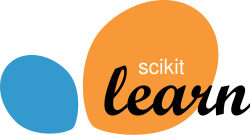| scikit-learn | |
|---|---|
 | |
| Original author | David Cournapeau |
| Developer | Google Summer of Code project |
| Initial release | June 2007 |
| Stable release | 1.8.0 [1] / 10 December 2025 |
| Repository | |
| Written in | Python, Cython, C and C++ [2] |
| Operating system | Linux, macOS, Windows |
| Type | Library for machine learning |
| License | New BSD License |
| Website | scikit-learn |
| This article is part of a series on |
| Python |
|---|
 |
scikit-learn (formerly scikits.learn and also known as sklearn) is a free and open-source machine learning library for the Python programming language. [3] It features various classification, regression and clustering algorithms including support-vector machines, random forests, gradient boosting, k-means and DBSCAN, and is designed to interoperate with the Python numerical and scientific libraries NumPy and SciPy. Scikit-learn is a NumFOCUS fiscally sponsored project. [4]